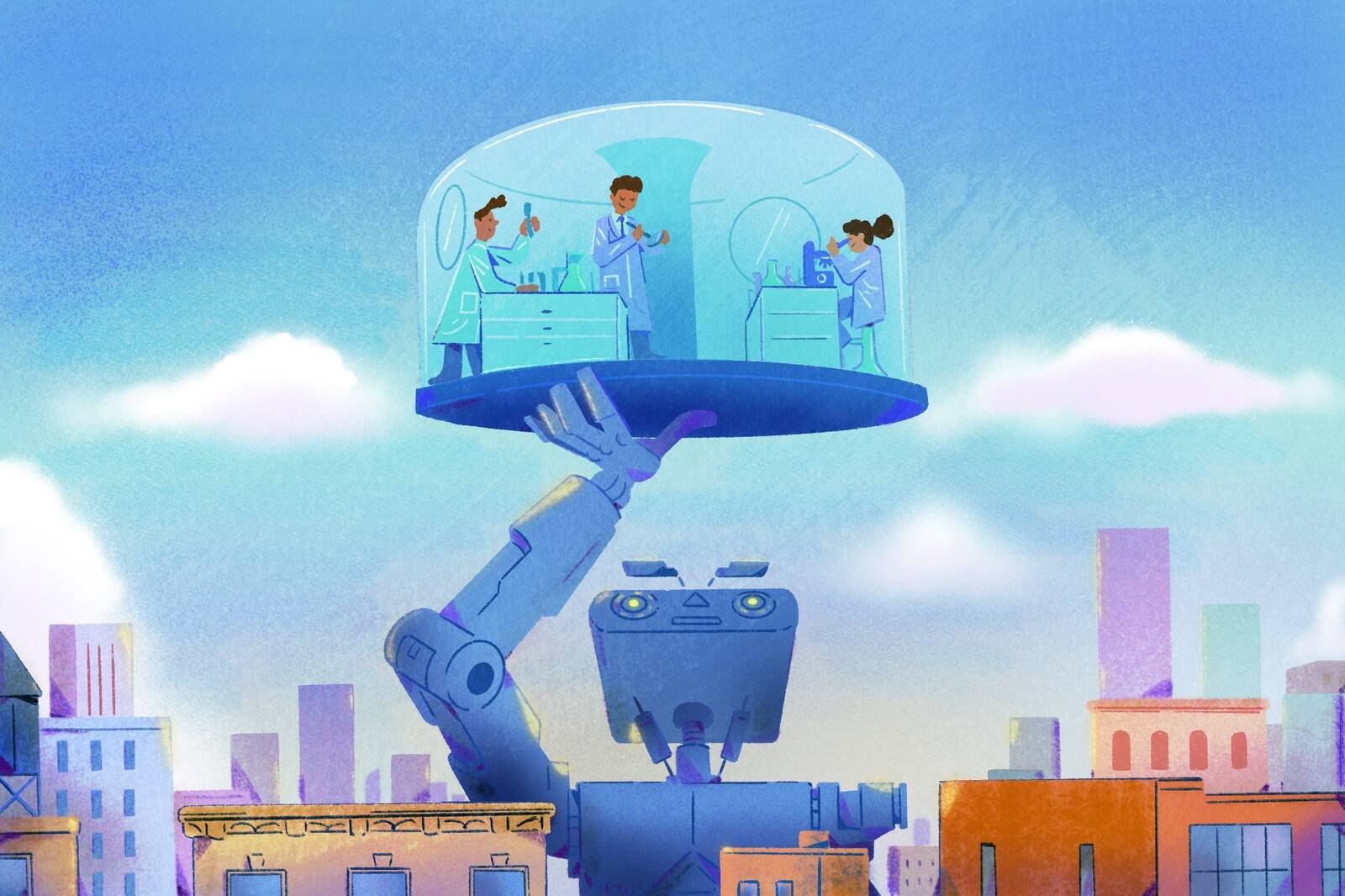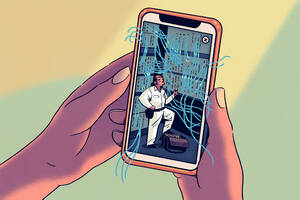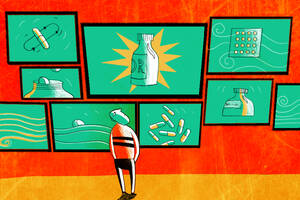In this roundup, we dive into research and insights from Kellogg faculty on AI’s past, present, and future, and its implications for scientists, advertisers, and the labor force.
While the ubiquity of artificial intelligence may seem like it happened all at once and very recently, its foundations were laid over the last century by mathematicians and engineers.
“We’ve accomplished a lot; we’ve come a long way in AI,” Kellogg finance professor Sergio Rebelo noted in a recent webinar on the past and future of AI. “But this progress only happened after many years of failures.”
Rebelo described how false assumptions about how to build computer programs with expertise hamstrung its progress. And he noted that this progress was possible because of sustained research funding.
“We are where we are because, despite failing for 50 years, the government has kept funding this research,” he says.
Despite all of the growth, AI still has plenty of issues that need to be solved. Hallucination, in which AI makes up part of the information it provides, is a common one. But from Rebelo’s viewpoint, deciding to stop using AI tools out of fear is a mistake—one that will only set people further back.
“There’s a lot of anxiety about people being replaced by AI,” Rebelo says. “I’m going to tell you—the first people who will be replaced are those who don’t know how to use AI. And they will be replaced not by AI but by people who know how to use AI.”
While artificial intelligence is often discussed as a game-changer for business, some think its most significant impact may be in another setting: the laboratory.
“I’d argue the central question today in AI is about whether AI can make new scientific discoveries, which is commonly viewed as the crucial milestone toward artificial general intelligence,” says Dashun Wang, a professor of management and organizations at Kellogg, where he also directs the Center for Science of Science and Innovation (CSSI) and codirects the Ryan Institute on Complexity.
To better understand how AI is currently benefiting science and how it will benefit science in the future, Wang and Jian Gao, a former research assistant professor at CSSI, assessed how scientists have used the technology over the past decade.
They found that, while AI has become widely used and influential, its benefits are unevenly distributed—with fewer advantages bestowed on disciplines that have higher shares of female and minority researchers, such as sociology.
They also found a huge gap in which disciplines are prepared to take advantage of AI. Beyond three core computational disciplines—computer science, mathematics, and engineering—disciplines were not investing enough in teaching AI-relevant skills to graduate students and junior scientists to achieve the full benefits from AI.
Their research pointed to a deep reliance on peers who have specialized knowledge to bridge the AI-training gap. This suggests that fully utilizing AI in science could require not just more funding to train scientists but more opportunities for interdisciplinary collaboration.
“Some institutions are launching interdisciplinary research centers, which encourage faculties from different disciplines to have conversations on how to leverage different AI tools and advances,” Gao says. “That would give researchers more exposure to each other to potentially learn from each other, when they’re actually doing research together.”
As simple as it is to generate realistic-looking images using AI, it can be more difficult to identify which online images are authentic and which have been AI-generated. But the diffusion models that transform text prompts into images tend to generate what Matt Groh calls “artifacts and implausibilities” that can offer viewers clues about the images’ origins.
“These models learn to reverse noise in images and generate pixel patterns in images that match text descriptions,” says Groh, an assistant professor of management and organizations at Kellogg. “But these models are never trained to learn concepts like spelling or the laws of physics or human anatomy or simple functional interactions between buttons on your shirt and straps on your backpack.”
Groh, along with colleagues Negar Kamali, Karyn Nakamura, Angelos Chatzimparmpas, and Jessica Hullman, recently used three text-to-image AI systems (Midjourney, Stable Diffusion, and Firefly) to generate a curated suite of images that illustrate some of the most common artifacts and implausibilities.
So what should you look for in an image to determine whether it may be artificially generated?
As you peruse an image you think may be artificially generated, taking a quick inventory of a subject’s body parts is an easy first step. AI models often create bodies that can appear uncommon—and even fantastical. So if the people in your image have extra limbs or digits, a face with hollow eyes or oddly shaped pupils, overlapping teeth, or other anatomical implausibilities, you may be looking at a fake.
Other signs include unrealistic coloring or skin textures, over-perfected portraits, mismatched lighting, gibberish texts, glitches in the appearance of common objects like backpacks and staircases, and unlikely interactions between people and things. Noticing these unusual details gives you an opportunity to slow down and check for further evidence that the image you’re looking at could be AI-generated.
“We as humans do operate on context,” Groh says. ‘We think about different cultures and what would be appropriate and what is a little bit like, ‘If that really happened, I probably would have heard about this.’”
For more tips and examples, Groh and his team have put together a handy report that is worth perusing.
Despite the push to incorporate artificial intelligence into a variety of workplace settings, it may be a long time before AI comes for your, or anyone else’s, job.
“Decades of research shows that fear is unfounded,” says Kellogg’s Hatim Rahman, an assistant professor of management and organizations.
In a recent The Insightful Leader Live webinar, Rahman described how AI’s incorporation into our work lives may not happen overnight.
“It’s going to take a long time for it to penetrate an industry, especially in ways that will affect your career,” says Rahman. Much will depend, then, upon how we choose to deploy it. And there is time for us to make this choice collectively and deliberately.
We can choose to use AI to replace as many workers as possible—or we can instead choose to use AI to bolster talent and identify it in underrecognized places. We can choose to let machines make the bulk of the decisions around our healthcare, education, and defense—or we can choose to keep humans at the helm, ensuring that human values and priorities rule the day.
Critical to prioritizing humans in this process is offering people across the workforce an opportunity to shape the employment decisions that affect them, “because without diverse voices and stakeholders, the design and implementation of AI has [reflected], and will reflect, a very narrow group of people’s interest,” Rahman says.
You can watch Rahman’s webinar here.
Imagine being moved by every ad you see online as if the advertisers know you, your personality, and the things that matter to you.
In the age of generative artificial intelligence, marketers will be able to mine our expanding digital footprints to make highly personalized ads, says Jacob Teeny, an assistant professor of marketing at the Kellogg School of Management.
“This specific influence tactic, personalized persuasion, is now going to be more scalable and widely deployed than ever before,” Teeny says.
Teeny and his research colleagues recently designed a series of studies to see how customers reacted to personalized pitches written by ChatGPT. They found that AI was able to write messages tailored to people’s complex psychological profiles, and these messages were more persuasive than non-tailored or generic messages.
Even when participants in a study were told that the ads they were being shown were generated by AI, that did not change the messages’ effectiveness. This is notable because prior research has shown that people try to resist being swayed when they know someone is trying to persuade them.
“We’ve seen a bit of cultural shifting in terms of the acceptability of being persuaded. When we go online, we know we’re getting targeted ads. And because that’s just become the norm so much, I think people are more OK with it,” Teeny said.
While marketers might view this as an opportunity to lean into deep personalization, for consumers, this new frontier of messaging requires them to be even more mindful of the content they read online.
“We’re going to be inundated with things that naturally feel like they appeal to us. So we might have to take a second step to really investigate the source or the veracity of the message—whether that’s in regard to a consumer product or in regard to a political news article,” Teeny says.




